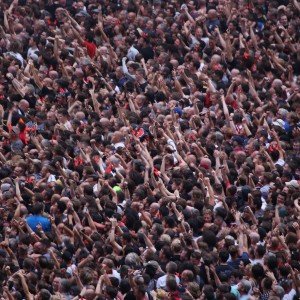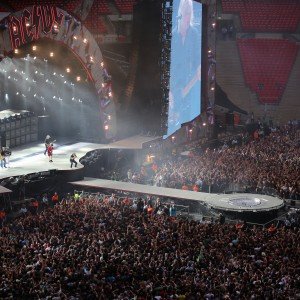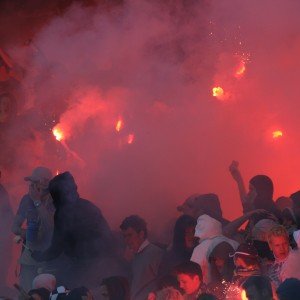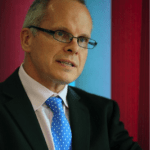Professor Chris Kemp, an expert in solutions for crowded space problems, looks at the way crowds react in certain situations, and the importance of planning and risk assessing at events.
The media’s preoccupation with panic as the universal answer to crowded space issues reduces and distorts the way in which the common person views the movement and dynamics of crowds. Often what is termed as collective crowd behaviour is in effect more individualistic and can be explained or defined in a number of ways. Three distinct categorisations and direct influencers often ignored are the time, space and context.
In previous articles and reports on Hillsborough, those involved in the incident were at first broadly identified as a hooligan element by the media rather than a disparate collective of unfortunate individuals caught up in the incident. This media stereotyping initially reduced the understanding of the incident and muddied public opinion, changing individual perceptions.

The nature of the crowd
The evolving nature of a crowd over a short period of time can cause many changes to take place. During the monitoring of a music event at a well-known outdoor park last summer in a six-minute time frame, the assembled crowd in the front of stage pit area had migrated through six of Alexander Berlonghi’s eleven types of crowd behaviour and characteristics.
The crowd moved from an ambulatory crowd, through the stages of cohesiveness, expressiveness, aggressiveness to an escaping and trampling crowd and finally becoming a dense or suffocating crowd. This was caused by the context of the event and modifications to the sensory signifiers (sight, hearing, taste, touch and smell) experienced by both individuals and groups.
In such cases the artist’s behaviour can either positively and/or negatively affect crowd behaviour. The event environment, the configuration of the barrier as well as the use of alcohol and drugs and perhaps high temperatures during the summer all play a part and can influence the outcome. Another element that can cause fluctuations in crowd behaviour is the close proximity and pressure experienced by those in the crowd. This has an effect on crowd behaviour in the crowded space.
The descriptive sound bite is all too often naïve in its delivery creating a label for crowding causing misjudgement and poor management responses in those not well versed in the management of the crowd. Best to leave this to the experts methinks rather than media conjecture. People are all too ready to count themselves as experts when in hindsight the reality of a situation is identified. In today’s world where qualifications on line can be attained without any understanding of how theory is transformed into practice and the word expert can mean a year in a junior position at a company, we simply do not have enough quality systems to support those in the industry making the right decisions in whom to employ. Expediency is often pursued in lieu of quality, pedigree or experience.

Understanding crowd behaviour
Understanding the individual and how groups behave in the crowded space moves us away from media and generic identification and the lumping together of individuals with tags such as panic, herd mentality and collectivism. This perspective moves us to a more circumspect view and points to more of the consideration of the individual rather than the creation of a pigeonhole that in many cases does not fit. Remember pigeonholes are only created to control and standardise activities (musical genres and behavioural psychologies to name but two).
In the aftermath of the recent Paris attacks the context changed both behaviour and perceptions. Individual and collective reactions to what would normally be everyday occurrences, a car backfiring or firecrackers being set off can cause normally rational human beings to act irrationally and panic in situations where under normal circumstances they would not have batted an eyelid.
The way in which our norms and values provide an underpinning foundation for our behaviours may change over time and in adverse situations often the flight or fight reflex sets in. However, an initial panic soon subsides providing rationality and enables the delivery of support mechanisms for others to kick in.
The impact of the senses on behaviour in a crowd is important. Work by Sime identified that different people focus on different contexts within the same environment reducing the possibility of mass panic, if indeed this phenomenon exists. In his work on fire, Sime’s general rule identifies that 25% of those in a fire move towards the source to get a closer look, 50% stay where they are (as if I am going to move out of my space at this concert just because I can smell burning) and 25% make immediately for the exits. This was borne out by the Station nightclub fire where 100 people lost their lives, 230 were injured and 132 escaped unhurt, chillingly close to the 25/50/25 rule.
At music events as identified by Tuan, those attending events where high densities occur find that all of their senses apart from the visual do not work to their full capacity. This can cause seemingly inoffensive actions to take on a more sinister appearance creating an unbalanced response to an innocuous incident. An example of this is when someone falls down in the crowd and a small number of people trip over them, this often results in cries of “crowd collapse” when this is not the case and the issue has been resolved within seconds. However, the surrounding crowd convinced of an imminent incident take unnecessary evasive action.
The other element specifically affecting crowds in anti-social environments is the inability to hear commands, communications or what others are saying in the aftermath of an incident. This can often stop remedial measures being taken as those involved are acting under a misapprehension of what is taking place, rather than the reality.
 Crowd profiling
Crowd profiling
Human Spatial mapping is an important aspect of crowd cognition that is often neglected. The hardwiring of place, space and time in peoples brains takes place after a few visits to any urban space and is a mechanism that can aid escape, exit or evacuation, as once the space and place is hardwired the individuals using the map understand the complexities of the layout and situational activity of the environment.
However, those visiting an area sporadically or for the first time have less knowledge of the layout and in an emergency situation either follow the crowd or panic as they have no idea where they are supposed to be going. Thus they move within the venue to where they entered and from our recent work at the O2 Arena it is clear that approximately 75% of people entering through an entrance will leave by the same door.
This mixture of different individuals with different and complex behaviours is difficult to manage and this is why crowd activity is so difficult to interpret in many circumstances. The crowd management professionals are experts at identifying this kind of activity. By using intelligence from other venues and events, profiling the crowd and by understanding the nature of the scientific and social constructs which govern behaviours they have important knowledge to help solve issues related to crowded space. These elements coupled with architecture, urban and suburban structures are folded together into a complex and fully rounded view that needs careful and expert advice to be appropriately understood.
What also must be clearly understood is that the management and planning for a crowd is not simply a mathematical calculation (although this is a useful part of the process). This is because people are not binary nor do they under stress act in a predictable manner. Their behaviours as I have pointed out in this article are influenced by many external influences and personal experiences which all must be considered in the planning process.
Our social structure helps us in making choices to support others in times of need and in Paris, in the Heysel Stadium disaster and of course who could forget the Bradford fire this came to the fore. We will put ourselves in mortal danger to save others.

Terrorism and the crowd
With the recent atrocities in Paris it is clear to see the difficulties facing events throughout the world. To the terrorist the success of the attack will be the high number of casualties realised and the propensity to be able to carry out similar attacks again with similar results. Already in the last four weeks the numbers purchasing tickets for events in both France and Switzerland have dropped by between 20 and 40% and those frequenting stadium, festival, and indoor venue shows are thinking twice about whether they will venture out.
The very nature of a terrorist attack is a chilling reminder that all events and festivals must take better precautions when in preparation. The past reliance on intelligence and infiltration has taken a battering as not only the single cell network operation has developed but also a much more sophisticated planning framework shrouded in secrecy has emerged.
Risk assessment and crowd management plans
In a fire the stimulus may be smell and the touch or the discomfort of the heat and smoke and this causes those involved to make a decision whether to stay or to leave the incident. In an explosion accompanying a fire, the visual and the aural combine with the smell and touch to create an over indulgence in the senses that causes those involved to make a decision based on their olfactory capacities and their ability to withstand the activity taking place.
Memory of previous incidents also creates a fight or flight mechanism response in the human as if someone has been involved in a previous incident their memory of this on all sensory levels will contribute to their reaction at the time and their capacity to support or help others going thought the same emotions.
The spatial differentiation within the crowd is also a significant game changer. However, in our recent research we have identified that in some cases it is preferable to have a high-density crowd at some events as this helps to control the occupants and to enable a safer management structure. In other events it seems safer to have a less dense crowd as this facilitates better relations between individuals and supports the team management of the venue or event. This however, must be carried out on an event-by-event basis and the event plan and risk assessment details why the densities have been prescribed. On viewing this type of calculation in action at the O2 Arena recently it is clear that there is a lot of mileage in carefully planning and developing the crowd configuration and density and using the event plan, crowd profiling and risk assessment to ensure that all permutations have been taken into consideration.
From an examination of Hall’s definitions of proximity and Urry’s work in this area it is clear that intimate space has changed over the last few decades. Whereas fifty years ago it was uncommon in everyday life for your intimate space to be breached, now in almost every daily occurrence we are in contact with people invading our intimate space, in shops, at events, in the street and in many public spaces such as markets and cafes.
Our social spaces have also changed and social media has created an immediacy to our lives that pervades society and means that any event or incident can be transferred immediately to many thousands of people. This is one reason for the importance of dynamic risk assessments. As our lives are continually in flux and decision-making is quicker than it has ever been, the dynamic nature of our need to solve problems means that changes are inevitable. The once enlarged planning envelope has now shrunk and the need for quick action and delivery of solutions means that the constant delivery of such speedy processes is paramount.
Social media is a blessing and a bane on our existence with fake videos, misleading messages and the impact that a picture of an atrocity can have. But also social media helps us to deliver effective and efficient communication to those within an event to avert a crisis or to help when an incident takes place.
So we come full circle from the issues in the media that lead to the pigeonholing and generic labelling of crowd activity, to social media’s attractive support mechanism to underpin safer events. However, what is really important is to understand the crowd and we can only do this by having a general appreciation of all aspects that affect the crowded space.
The creation of a dynamic crowd management plan with contingency elements which delivers not only on the known but also on the what ifs, to secure the way we prepare for, deliver and reflect upon the event or crowded space is important to create and maintain. We have short memories both in the management and attendance of events and to deliver a short-term solution is not the way forward but improving continually on the planning for and delivery of the event is an essential step to the understanding and securing of the crowded space.
 Professor Chris Kemp is a former rock promoter, venue manager and University Pro-Vice-Chancellor. His current business MOM, provides solutions for crowded space problems and has developed a suite of successful university credit rated Level 5 courses in crowded space, risk, safety, fire and emergency management in conjunction with Chartered safety consultants, who specialise in crowd and event safety.
Professor Chris Kemp is a former rock promoter, venue manager and University Pro-Vice-Chancellor. His current business MOM, provides solutions for crowded space problems and has developed a suite of successful university credit rated Level 5 courses in crowded space, risk, safety, fire and emergency management in conjunction with Chartered safety consultants, who specialise in crowd and event safety.
These courses are scenario based and those participating put theories into practice so that a full understanding of each concept is attained. A list of courses in the new year in Sunderland, Great Missenden and Southampton can be found at www.momconsultancy.com or contact Hayley on [email protected] or ring 07834 140598 or 01234 964020.
The Safety Conversation Podcast: Listen now!
The Safety Conversation with SHP (previously the Safety and Health Podcast) aims to bring you the latest news, insights and legislation updates in the form of interviews, discussions and panel debates from leading figures within the profession.
Find us on Apple Podcasts, Spotify and Google Podcasts, subscribe and join the conversation today!







Professor Kemp makes reference to various research undertaken into crowd management yet there are no references accompanying this article for those of us who wish to pursue our interest further.